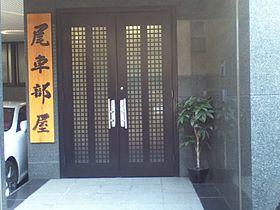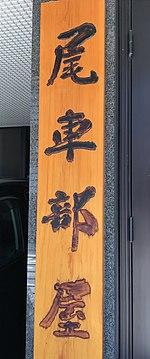Oguruma stable (尾車部屋, Oguruma-beya) is a stable of sumo wrestlers, one of the Nishonoseki group of stables. In its modern form it dates from March 1987 when it was founded by Kotokaze, a former Sadogatake stable wrestler.[1] The first wrestler from the stable to achieve sekitori status was Tomikaze in July 2000. Initially the stable had a policy of not accepting foreign born wrestlers or college recruits, but this was waived when Chuo University graduate Takekaze personally asked to join in 2002. Their first foreigner was the Mongolian Hoshikaze, who joined in the same year and eventually reached jūryō but was thrown out of sumo after the 2011 match-fixing scandal. The stable absorbed Oshiogawa stable in 2005 ahead of the retirement of Oshiogawa-oyakata, with Wakakirin and Wakatoba among the wrestlers transferring over. As of January 2021, it has 15 wrestlers. The stable has produced six makuuchi or top division wrestlers since its founding - Takekaze, Yoshikaze, Wakakirin, Kimikaze, Amakaze, and Yago.[1]
Ring name conventions
Almost all wrestlers at this stable take ring names or shikona that end with the character 風 (read: kaze), meaning wind or breeze, in deference to their coach and the stable's owner, the former Kotokaze.
Owner
- 1987-present: 8th Oguruma (riji, former ōzeki Kotokaze)
Notable active wrestlers
- Amakaze (best rank maegashira)
- Tomokaze (best rank maegashira)
- Yago (best rank maegashira, won ″Amateur Yokozuna″ title in December 2016[2])
Notable former wrestlers
Coaches
- Nakamura Masatsugu (toshiyori, former Sekiwake Yoshikaze)
- Oshiogawa Akira (toshiyori, former Sekiwake Takekaze)
Assistant
- Nishikikaze (sewanin, former makushita, real name Yasuyuki Adachi)
Usher
- Rokurō (jūryō yobidashi, real name Kenzō Araki)
Hairdresser
- Tokogō (1st class tokoyama)
Location and access
Tokyo, Edogawa ward, Kiyosumi 2-15-5
3 minutes from Kiyosumi-shirakawa Station on the Toei Ōedo Line and Hanzōmon Line
See also
- List of sumo stables
- List of active sumo wrestlers
- List of past sumo wrestlers
- Glossary of sumo terms
References
- ^ a b "2019 January Grand Sumo Tournament Banzuke Topics". Japan Sumo Association. Archived from the original on 14 January 2019. Retrieved 14 January 2019.
- ^ "Looking up to Kisenosato as a role model". Japan News. Retrieved 7 May 2018.
External links
- Japan Sumo Association profile
- Homepage in Japanese

